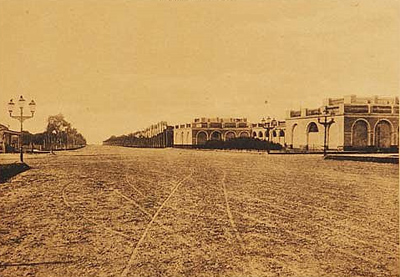
Parque 3 de Febrero commemorates the Battle of Caseros where Confederate forces defeated Juan Manuel de Rosas in 1852. Ending 17 years of what many historians call Argentina’s first dictatorship, the victors forced Rosas to leave the country & confiscated his land. This singular act would transform Buenos Aires in ways unimaginable at the time. Technically, Rosas had lived outside the city limits (which only extended to Avenida Callao). In fact, the town of Belgrano had not even been incorporated… that would happen a few years later in 1857.
Fast forward to 1875, when President Nicolás Avellaneda officially inaugurated the park. Nestled in between the populations of Buenos Aires & Belgrano, it immediately became one of the most popular places for the rich & famous… just read “La Gran Aldea” by Lucio Vicente López for an example of the park’s importance to high society. During these years, Argentina coalesced into a nation & Buenos Aires became the undisputed capital. City limits expanded past Belgrano, making Parque 3 de Febrero the largest green space in town. Many improvements were made for the centennial & it continues to be one of the most visited spots for porteños.
But where exactly did Rosas live? Quite the palatial residence of the time, it served to train the military until President Roca ordered its demolition in 1899. A few photos & some art work can be found online depicting the building:



The mansion was at the intersection of Avenidas Sarmiento & Libertador, where a statue of Sarmiento by Rodin is placed today. Ironic since Sarmiento was one of the most outspoken opposers of Rosas; his victory was complete. But these days Rosas looks directly down at Sarmiento & where he used to live. During the presidency of Menem, Rosas finally got his own monument —taller than that of Sarmiento & placed catacorner to the former location of his residence.


Investigating where Rosas lived brought to light something amazing —just how much land Rosas possessed. According to the publication “Buenos Aires nos cuenta #20,” Rosas owned practically the entire coastline of modern Buenos Aires from Nuñez to the outskirts of Recoleta. The map below is based on their research which shows all the separate lots purchased by Rosas over the ten years from 1838 to 1848. The total area amounts to an astounding 541 hectares, including sections of what is today Barrio Parque, the zoo, La Rural, the US embassy, polo grounds, a race track, the current River Plate stadium, water treatment plants… the list goes on & on. It’s mind-boggling to think about the value of this land, even if it is no longer riverfront property.
The foresight involved to maintain a park on his land is also noteworthy. So much could have been developed at some time during the 20th century, yet it wasn’t. I think local historians downplay that remarkable fact. And so much of the current city’s street plan owes its existence to original lot divisions from the time of Rosas… one more example of how the past can be seen in present-day Buenos Aires.

Robert, I’ve been looking at your blogs since 2005,no joke! I’am finally making a comment. Please show pics of Bas. of Charles barremeo in Almagro. I’am an Argentinophile from L.A.
Hi Jeff – I’ll take pics of the church & post them as soon as I can. No problem… I have to update the post about churches anyway. Probably by next week. Thanks for finally making a comment after all these years! 🙂